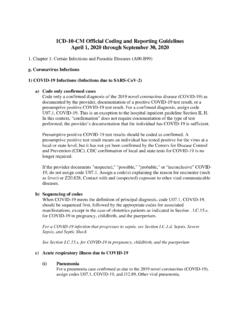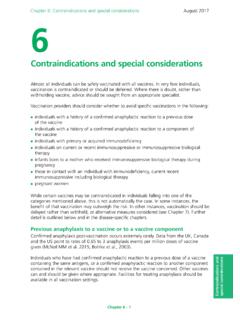Transcription of Summary of Infection Prevention Practices in Dental ...
1 Summary of Infection Prevention Practices in Dental Settings: Basic Expectations for Safe Care MODULE 4 respiratory Hygiene/. Cough Etiquette MODULE 4 respiratory Hygiene/Cough Etiquette Modules in the Slide Series 1. Introduction 2. Hand Hygiene 3. Personal Protective Equipment 4. respiratory Hygiene/Cough Etiquette (this module). 5. Sharps Safety 6. Safe Injection Practices 7. Sterilization and Disinfection of Patient-Care Items and Devices 8. Environmental Infection Prevention and Control 9. Dental Unit Water Quality 10. Program Evaluation Slide 2. MODULE 4 respiratory Hygiene/Cough Etiquette New Elements Added to Standard Precautions in 2007. Infection control problems that are identified in the course of outbreak investigations often indicate the need for new recommendations or reinforcement of existing Infection control recommendations to protect patients.
2 Two areas of practice relevant to dentistry were added: respiratory hygiene/cough etiquette. Safe injection Practices . Source: Guideline for Isolation Precautions: Preventing Transmission of Infectious Agents in Healthcare Settings (2007). Slide 3. MODULE 4 respiratory Hygiene/Cough Etiquette respiratory Hygiene/Cough Etiquette Based on observations made during severe acute respiratory syndrome (SARS) outbreaks, where failures to implement simple source control measures with patients, visitors, and health care personnel with respiratory symptoms may have contributed to SARS transmission. Source: Guideline for Isolation Precautions: Preventing Transmission of Infectious Agents in Healthcare Settings (2007). Slide 4. MODULE 4 respiratory Hygiene/Cough Etiquette respiratory Hygiene/Cough Etiquette Combination of Infection Prevention measures designed to limit the transmission of respiratory pathogens spread by droplet or airborne routes.
3 First point of encounter. Strategies target: Patients and visitors who might have undiagnosed transmissible respiratory infections . Anyone with signs of illness, including cough, congestion, runny nose, or increased production of respiratory secretions. Source: respiratory Hygiene/Cough Etiquette in Healthcare Settings Slide 5. MODULE 4 respiratory Hygiene/Cough Etiquette Measures to Contain respiratory Secretions Cover mouth and nose with a tissue when coughing or sneezing. Use the nearest waste receptacle to dispose of tissues after use. Perform hand hygiene after having contact with respiratory secretions and contaminated objects or materials. Offer masks to coughing patients and other symptomatic people when they enter the Dental setting. Encourage people with symptoms to sit as far away from others as possible.
4 Source: respiratory Hygiene/Cough Etiquette in Healthcare Settings Slide 6. MODULE 4 respiratory Hygiene/Cough Etiquette Visual Alerts Display visual cues to remind staff and patients of proper ways to prevent spread of respiratory pathogens. Related materials are available at Cover Your Cough and Important Notice to All Patients . Slide 7. MODULE 4 respiratory Hygiene/Cough Etiquette Supplies Dental health care facilities should ensure the availability of: Tissues and no-touch waste receptacles for disposing of used tissues. Dispensers of alcohol-based hand rub and handwashing materials (when a sink is available). Masks (for coughing patients and other people with symptoms). Slide 8. MODULE 4 respiratory Hygiene/Cough Etiquette Additional Considerations DHCP should be educated on how to prevent the spread of respiratory pathogens when in contact with people with symptoms.
5 CDC recommends that health care workers get one dose of influenza vaccine annually. Slide 9. MODULE 4 respiratory Hygiene/Cough Etiquette respiratory Hygiene and Cough Etiquette Resources CDC. 2007 Guideline for Isolation Precautions: Preventing Transmission of Infectious Agents in Healthcare Settings CDC. Influenza (Flu) website: respiratory Hygiene/Cough Etiquette in Healthcare Settings CDC. Influenza (Flu) website: Cover Your Cough CDC. Summary of Infection Prevention Practices in Dental Settings: Basic Expectations for Safe Care Slide 10. End of Module 4. For more information, contact Centers for Disease Control and Prevention (CDC). 1-800-CDC-INFO (232-4636). TTY:1-888-232-6348 The findings and conclusions in this report are those of the authors and do not necessarily represent the official position of the CDC.














